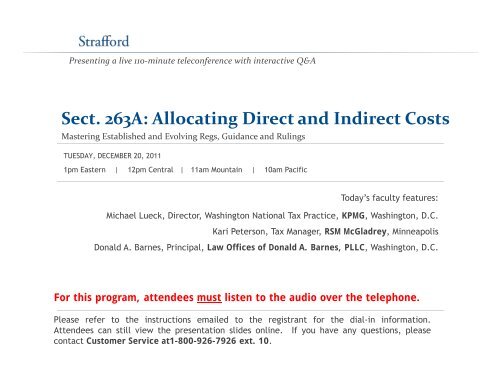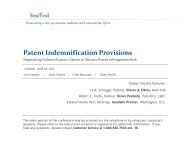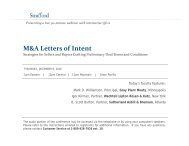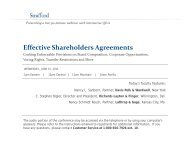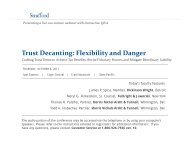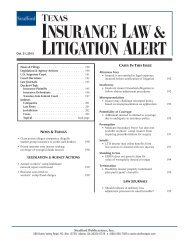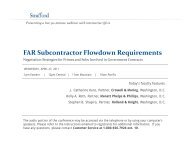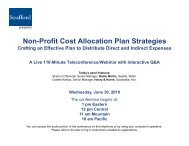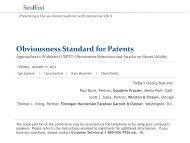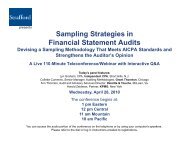Sect 263A: Allocating Direct and Indirect Costs Sect. 263A ... - Strafford
Sect 263A: Allocating Direct and Indirect Costs Sect. 263A ... - Strafford
Sect 263A: Allocating Direct and Indirect Costs Sect. 263A ... - Strafford
Create successful ePaper yourself
Turn your PDF publications into a flip-book with our unique Google optimized e-Paper software.
Presenting a live 110‐minute teleconference with interactive Q&A<strong>Sect</strong>. <strong>263A</strong>: <strong>Allocating</strong> <strong>Direct</strong> <strong>and</strong> <strong>Indirect</strong> <strong>Costs</strong>Mastering Established <strong>and</strong> Evolving Regs, Guidance <strong>and</strong> RulingsTUESDAY, DECEMBER 20, 20111pm Eastern | 12pm Central | 11am Mountain | 10am PacificToday’s faculty features:Michael Lueck, <strong>Direct</strong>or, Washington National Tax Practice, KPMG, Washington, D.C.Kari Peterson, Tax Manager, RSM McGladrey, MinneapolisDonald A. Barnes, Principal, Law Offices of Donald A. Barnes, PLLC, Washington, D.C.For this program, attendees must listen to the audio over the telephone.Please refer to the instructions emailed to the registrant for the dial-in information.Attendees can still view the presentation slides online. If you have any questions, pleasecontact Customer Service at1-800-926-7926 ext. 10.
Continuing Education CreditsFOR LIVE EVENT ONLYAttendees must listen to the audio over the telephone. Attendees can still viewthe presentation slides online but there is no online audio for this program.Please refer to the instructions emailed to the registrant for additionalinformation. If you have any questions, please contact Customer Serviceat 1-800-926-7926 ext. 10.
<strong>Sect</strong>. <strong>263A</strong>: 6A <strong>Allocating</strong> <strong>Direct</strong> <strong>and</strong><strong>Indirect</strong> <strong>Costs</strong> SeminarDec. 20, 2011Michael Lueck, KPMGmlueck@kpmg.comKari Peterson, RSM McGladreyKariE.Peterson@mcgladrey.comDonald A. Barnes, Law Offices of Donald A.Barnes, PLLCdbarnes@washingtontaxlaw.com
Today’s ProgramFundamental <strong>Sect</strong>. <strong>263A</strong> Concepts[Michael Lueck <strong>and</strong> Kari Peterson]Slide 7 – Slide 30Relevant <strong>Sect</strong>. <strong>263A</strong> Guidance[Michael Lueck <strong>and</strong> Kari Peterson]Slide 31 – Slide 47Ongoing Compliance Challenges Under <strong>Sect</strong>. <strong>263A</strong>[Donald A. Barnes]Slide 48 – Slide 58
NoticeANY TAX ADVICE IN THIS COMMUNICATION IS NOT INTENDED ORWRITTEN BY KPMG TO BE USED, AND CANNOT BE USED, BY ACLIENT OR ANY OTHER PERSON OR ENTITY FOR THE PURPOSE OF(i) AVOIDING PENALTIES THAT MAY BE IMPOSED ON ANY TAXPAYEROR (ii) PROMOTING, MARKETING OR RECOMMENDING TO ANOTHERPARTY ANY MATTERS ADDRESSED HEREIN.You (<strong>and</strong> your employees, representatives, or agents) may disclose to any <strong>and</strong> allpersons, without limitation, the tax treatment or tax structure, or both, of any transactiondescribed in the associated materials we provide to you, including, but not limited to, anytax opinions, memor<strong>and</strong>a, or other tax analyses contained in those materials.The information contained herein is of a general nature <strong>and</strong> based on authorities that aresubject to change. Applicability of the information to specific situations should bedetermined through consultation with your tax adviser.© 2011 KPMG LLP, a Delaware limited liability partnership <strong>and</strong> the U.S. member firm of the KPMG network of independent member firms affiliated with KPMG International Cooperative(“KPMG International”), a Swiss entity. All rights reserved. KPMG <strong>and</strong> the KPMG logo are registered trademarks of KPMG International Cooperative (“KPMG International”), a Swiss entity.
Michael Lueck, KPMGKari Peterson, RSM McGladreyFUNDAMENTAL SECT. <strong>263A</strong>CONCEPTS
<strong>Sect</strong>. <strong>263A</strong> – Computational Steps• Step 1- Identify inventory costs reflected on financial statements(full absorption)• Step 2- Identify additional <strong>Sect</strong>. <strong>263A</strong> inventoriable costs• Step 3- Allocate inventory costs between ending inventory <strong>and</strong>cost of goods sold10
Step 1 – Underst<strong>and</strong> FullAbsorption Inventory Method• Required prior to enactment of <strong>Sect</strong>. <strong>263A</strong>• <strong>Sect</strong>. 471 costs (key term)- <strong>Direct</strong> production costs- <strong>Indirect</strong> production costs• Category 1: Always capitalized• Category 2: Not capitalized• Category 3: Possibly capitalized but generally relatedto production activities11
Step 1 – Full Absorption <strong>Indirect</strong>Cost Allocation Methods• Burden rate- Objective → Allocate appropriate amount of indirectproduction costs to ending inventory- Operation → Use pre-determined rates to approximatecosts- Adjustment → Variances, if material, adjust endinginventory• St<strong>and</strong>ard cost- Requires allocation of net positive or negative overheadvariance to ending inventory- St<strong>and</strong>ard/budgeted costs used to approximate costs12
Step 2 – Identify And AllocateAdditional <strong>Sect</strong>. <strong>263A</strong> <strong>Costs</strong>• Regulations identify 23 types of indirect production costs.- Allocable share of administrative, service or supportfunctions• Determine what costs are already capitalized under taxpayer’sfull absorption method.- Regulations do not really address how this should beaccomplished.- <strong>Sect</strong>. 471 costs may include some of these costs.• Approaches- Account-by-account t analysis- Department analysis13
Step 2 – Additional <strong>Sect</strong>. <strong>263A</strong><strong>Indirect</strong> Production <strong>Costs</strong>• <strong>Indirect</strong> labor• Officer’s compensation• Pension <strong>and</strong> other related costs• Employee benefits• <strong>Indirect</strong> materials• Purchasing costs• H<strong>and</strong>ling costs• Storage costs• Cost recovery• Quality control• Interest (only if <strong>Sect</strong>. <strong>263A</strong>(f)applies)• Bidding costs (successful bids)• Depletion• Rent• Taxes (other than income)• Insurance• Utilities• Repairs <strong>and</strong> maintenance• Engineering <strong>and</strong> design(non-<strong>Sect</strong>. 174 costs)• Spoilage• Tools <strong>and</strong> equipment• Licensing <strong>and</strong> franchisecosts• Capitalizable service costs14
Step 2 – <strong>Costs</strong> Not Capitalized• Selling <strong>and</strong> distributioncosts• <strong>Sect</strong>. 174 costs• <strong>Sect</strong>. 179 expenses• <strong>Sect</strong>. 165 losses• Cost recovery of idleassets• Income taxes• Strike costs• Warranty costs• On-site storage costs atretail store facility• Unsuccessful bids• Deductible service costs(see next slide)15
Step 2 – Deductible Service <strong>Costs</strong>• Overall management or • Insurance or riskpolicy-setting• Strategic business planning• General financial accounting• General financial planning<strong>and</strong> management• Personnel policy• Quality control policy• Safety engineering policymanagement policy• Environmentalmanagement policy• General economicanalysis <strong>and</strong> forecasting• Internal audit• Shareholder, public <strong>and</strong>industrial relations• Tax services• Marketing, selling oradvertising16
Step 2 – <strong>Allocating</strong> <strong>Costs</strong>Among Departments• Specific identification method• Allocation methods- Burden rate- St<strong>and</strong>ard cost method- Significant variances capitalized to ending inventory• Any other reasonable method- Total costs capitalized not significantly different from othermethods- Applied consistently- Does not circumvent <strong>Sect</strong>. <strong>263A</strong> requirements- Allocates costs to specific items in inventory (TAM9717002)17
Step 2 – <strong>Allocating</strong> <strong>Costs</strong> OfMixed Service Departments• Mixed service costs- Partially allocable to production or capitalizable resaleactivities, <strong>and</strong> partially allocable to deductible activities• Accounting• Payroll• HR• IT• Legal18
Step 2 – <strong>Allocating</strong> <strong>Costs</strong> Of MixedService Departments (Cont.)• Concept of allocations- Manufacturer has two divisions <strong>and</strong> a personneldepartment that serves both divisions.- Personnel department has $50,000 000 of costs.- Division 1 has 40 employees; 30 are in non-productionactivities.- Division 2 has 60 employees; 40 are in non-productionactivities.- How much of the personnel department costs are actuallyinventoriable?19
Step 2 – <strong>Allocating</strong> <strong>Costs</strong> Of MixedService Departments (Cont.)• Self-developed method- Categorize costs of mixed service department• Entirely production• Entirely non-production• Partially related to production <strong>and</strong> non-production20
Step 2 – <strong>Allocating</strong> <strong>Costs</strong> Of MixedService Departments (Cont.)• <strong>Direct</strong> reallocation- Total costs of all mixed service departments are allocatedto production departments.- Ignores benefits of service departments servicing oneanother- Use this method when you want to maximize taxableincome.21
Step 2 – <strong>Allocating</strong> <strong>Costs</strong> Of MixedService Departments (Cont.)• Step-allocation- Sequence of allocations- Begin with service department benefiting the most otherdepartments- Allocate costs to:• Manufacturing operations• Other service departmentst• Non-service departments (financial planning, taxdepartment) benefiting only non-production activities22
Step 2 – <strong>Allocating</strong> <strong>Costs</strong> Of MixedService Departments (Cont.)• Elective 90-10 de minimis rule- Treas. Reg. 1.<strong>263A</strong>-1(g)(4)(ii)• 90% or more of MSD costs deductible; 100% areperiod costs• 90% or more of MSD costs capitalizable; 100% areinventoriable• Constitutes a method of accounting• Applies to all mixed service departments23
Step 2 – <strong>Allocating</strong> <strong>Costs</strong> Of MixedService Departments (Cont.)• Simplified service cost method- Applies to all inventory- At election, certain self-constructed assets may beexcluded- Applies to all activities of the trade or business- Formula• Allocation ratio x total t mixed service costs– Total MSCs means total department costs.– Risk/exposure if SSCM ratio applied to less thantotal department costs24
Step 2 – <strong>Allocating</strong> <strong>Costs</strong> Of MixedService Departments (Cont.)- Allocation ratio• Production cost allocation ratio– Total production costs/total costs, less mixed servicecosts <strong>and</strong> interest• Labor cost allocation ratio– Manufacturero Total production labor costs/total labor costs, lessmixed service labor– Resellero Total purchasing labor costs/total labor costs, lessmixed service laboroTotal storage <strong>and</strong> h<strong>and</strong>ling labor costs/total laborcosts, less mixed service labor– 1/3 – 2/3 ruleoElection, method of accounting25
Step 3 – <strong>Allocating</strong> Additional<strong>Sect</strong>. <strong>263A</strong> <strong>Costs</strong> To Inventory• Self-developed- Specific identification- Burden rates- St<strong>and</strong>ard cost- Do not confuse these with methods previously discussed.• Simplified- With or without historic absorption ratio26
Step 3 – <strong>Allocating</strong> Additional <strong>Sect</strong>.<strong>263A</strong> <strong>Costs</strong> To Inventory (Cont.)• Simplified production or resale method (without HAR election)- Step 1 – Compute absorption ratio• Total additional <strong>Sect</strong>. <strong>263A</strong> costs (except interest) /total <strong>Sect</strong>. 471 costs– Split absorption ratio, if a resellero Purchasing costs ratiooStorage <strong>and</strong> h<strong>and</strong>ling costs ratio- Step 2 – Use absorption ratio to allocate costs to endinginventory• Absorption ratio x ending FIFO inventory (or LIFOincrement)27
Step 3 – <strong>Allocating</strong> Additional <strong>Sect</strong>.<strong>263A</strong> <strong>Costs</strong> To Inventory (Cont.)• Simplified production method, withouthistoric absorption28
Step 3 – <strong>Allocating</strong> Additional <strong>Sect</strong>.<strong>263A</strong> <strong>Costs</strong> To Inventory (Cont.)• Simplified resale method, without historicabsorption (Cont.)PurchasingStorage <strong>and</strong> CombinedAbsorption + H<strong>and</strong>ling = AbsorptionRatio Absorption Ratio RatioCombinedAbsorption RatioxEnding FIFO Inventoryor (LIFO increment)29
Step 3 – <strong>Allocating</strong> Additional <strong>Sect</strong>.<strong>263A</strong> <strong>Costs</strong> To Inventory (Cont.)• Simplified production or resale method (with HAR election)- Steps are the same as without historic absorption ratio.- Absorption ratio is set based upon prior three years’ use ofsimplified production method.- Advantage of HAR• Simplicity, as <strong>Sect</strong>. <strong>263A</strong> calculation need only becompleted once over the qualifying period (five years)- Disadvantage• Must be used over the qualifying period, even ifoperations change30
Michael Lueck, KPMGKari Peterson, RSM McGladreyRELEVANT SECT. <strong>263A</strong>GUIDANCE
Sales-Based Royalties• In general, royalty payments are required to be capitalized tothe extent properly allocable to property produced or acquiredfor resale. Treas. Reg. 1.<strong>263A</strong>-1(e)(3)(ii)(U)1(e)(3)(ii)(U)• Sales-based royalties- Plastic Engineering & Technical Services, Inc. v. Comm’r,T.C. Memo 2001-324- Robinson-Knife Manufacturing Co. v. Comm’r, 600 F.3d121 (2nd Cir. 2010)• Facts-<strong>and</strong>-circumstances v. simplified methods of allocatingcosts between ending inventory <strong>and</strong> cost of goods sold32
Proposed Regulations• Provide that licensing <strong>and</strong> franchising costs (in the form of afee, payment or royalty) that are incurred only upon the sale ofinventory produced or acquired for resale are only allocable tothe property that has been sold (or deemed to be sold underthe taxpayer’s inventory cost flow assumption)- Follows the result, but not the rationale, of the SecondCircuit decision in Robinson Knife Manufacturing v.Comm’r, 600 F.3d 121 (2d Cir. 2010)- See AOD 2011-01, which provides that the IRS does notagree that sales-based royalties are selling expenses33
Proposed Regulations (Cont.)• Also proposes to amend Reg. §§1.<strong>263A</strong>-2 <strong>and</strong> -3 to provide(simplified production <strong>and</strong> resale methods) as follows:- Additional <strong>Sect</strong>. <strong>263A</strong> costs, <strong>Sect</strong>. 471 costs incurredduring gy year, <strong>and</strong> <strong>Sect</strong>. 471 costs remaining on h<strong>and</strong> atyear-end, do not include sales-based royalties.• Applies to tax years ending on or after the publication as finalregulations.- LB&I-4-0211 (Mar. 1, 2011): Field directive advisesexaminers not to expend resources challenging ataxpayer’s treatment that is consistent with the proposedregulations.34
Impact On Simplified Formulas: Example• Simplified production method, withouthistoric absorption35
Proposed Regulations: Sales-BasedVendor Allowances• Prop. Reg. § 1.471-3(e)- Vendor allowances include allowances, discounts or pricerebates a taxpayer earns by selling specific merch<strong>and</strong>ise.- Amends current regulations to provide that a sales-basedvendor allowance is an adjustment only to the cost ofmerch<strong>and</strong>ise sold during the year- Would prohibit use of specific tracing method to allocate toending inventory36
Proposed Regulations: Sales-BasedVendor Allowances (Cont.)• Prop. Reg. § 1.471-3(e), Cont.- Also proposes to amend Reg. §§1.<strong>263A</strong>-2 <strong>and</strong> -3 toprovide (simplified production <strong>and</strong> resale methods) asfollows:• Additional <strong>Sect</strong>. <strong>263A</strong> costs, <strong>Sect</strong>. 471 costs incurredduring year, <strong>and</strong> <strong>Sect</strong>. 471 costs remaining on h<strong>and</strong> atyear-end do not include cost reductions described in§1.471-3(e).• Proposed to be effective for tax years ending on or afterpublication of final regulations37
Tax Accounting Guidance Plan:Negative <strong>263A</strong> <strong>Costs</strong>• Negative <strong>Sect</strong>. <strong>263A</strong> costs are costs not required or permittedto be capitalized for tax purposes, but are capitalized forfinancial reporting purposes. p- Schedule M adjustments (e.g., book-over-tax depreciation)- Not capitalized for tax (e.g., <strong>Sect</strong>. 174 costs)• Need to convert book inventories to a tax basis- Simplified approach- Replication of costing system on a tax basis• IRS concern that removal of costs under a simplified approachwill generally differ from costs removed using the taxpayer’sbook allocation methodology; TAM 20060702138
Tax Accounting Guidance Plan:Negative <strong>263A</strong> <strong>Costs</strong> (Cont.)Notice 2007-29 provides:• The Service will not challenge the inclusion of negativeamounts in computing additional costs under <strong>Sect</strong>. <strong>263A</strong>.• The IRS will not continue to pursue the issue in any tax yearending on or before the publication of anticipated guidance.• The IRS will not deny consent for the changes in method ofaccounting that involve negative <strong>263A</strong> costs.• Government also requests comments.39
Proposal For Negatives• Proposal for new absorption ratio40
Retail Industry Issue Resolution Program• Field directive (LMSB-04-0910-026)- Advises exam to treat SBVAs <strong>and</strong> MPPs as purchase priceadjustment, NOT income- Advises exam to continue to rely on Treas. Reg. §1.471-8to calculate ending inventory under RIM41
Proposed Regulations: RetailInventory MethodTreas. Reg. 1.471-8 cost complement:To approximate lower of cost or market, 1.471-8(d)allows a taxpayer to exclude permanent mark-downsfrom the denominator.42
Proposed Regulations: RetailInventory Method, ExampleOne item purchased, <strong>and</strong> one item in EI43
Proposed Regulations: RetailInventory Method (Cont.)• Numerator of cost complement may not be reduced by amountof allowance, discount or price rebate:- Earned by selling specific merch<strong>and</strong>ise- Related to or intended to compensate for permanentreduction in retail selling price of inventory• Margin protection payment or mark-down allowance• Denominator of cost complement excludes mark-downs.44
Proposed Regulations: RetailInventory Method (Cont.)• Adjustment to inventory value related to permanent mark-ups<strong>and</strong> mark-downs made by adjustment to retail selling price ofending inventory- Comments requested on alternatives to computing LCMunder RIM• Neither cost complement nor ending retail selling pricesadjusted for temporary mark-downs <strong>and</strong> mark-ups• Will apply to tax years beginning after date published as final45
Treatment Of Automobile DealerStorage And H<strong>and</strong>ling <strong>Costs</strong>Broad definition of motor vehicle dealershipretail sales facility safe harbor• Treat entire facility as retail sales facility• Vehicle lot routinely visited by retail customers• Not required to capitalize storage <strong>and</strong> h<strong>and</strong>ling costs46
Treatment Of Automobile DealerStorage And H<strong>and</strong>ling <strong>Costs</strong> (Cont.)Reseller without production activities safe harbor• Motor vehicle dealership may treat itself as a reseller withoutproduction activities.• H<strong>and</strong>ling costs relating to activities performed on dealershipowned or customer owned vehicles not capitalized• Must capitalize the cost of vehicle parts• Use of “negative” additional <strong>Sect</strong>. <strong>263A</strong> costs prohibited• Automatic change47
Donald A. Barnes, Law Offices of Donald A. Barnes, PLLCONGOING COMPLIANCECHALLENGES UNDER SECT.<strong>263A</strong>
Application Of Robinson Knife To Resellers• Regulations apply to both producers <strong>and</strong> resellers• Description of guidance changed• Robinson Knife <strong>and</strong> Plastic Engineering• TAM 200630019• Comments submitted to Treasury: All relate to producers49
Resellers• Sales-based royalties: Inventory purchased for resale• Royalties payable to supplier or third party• Similar to additional earn-out payment50
Example• Taxpayer incurs $100 to purchase product for resale.• Upon sale, taxpayer becomes obligated to pay additional $5.• <strong>Direct</strong> acquisition cost of product is $105.• $5 is an IRC §471 cost, not an additional IRC §<strong>263A</strong> cost.51
IRC §<strong>263A</strong> 6A <strong>Costs</strong> For Resellers• Treas. Reg. §1.<strong>263A</strong>-3(c)(1): 3( <strong>Indirect</strong> costs most often incurredby resellers―Purchasing, h<strong>and</strong>ling, storage costs• Treas. Reg. §1.<strong>263A</strong>-3(c)(2) through (5)―<strong>Costs</strong> attributable to purchasing, h<strong>and</strong>ling <strong>and</strong> storage• G&A costs that directly benefit or incurred by reason ofpurchasing, h<strong>and</strong>ling <strong>and</strong> storage activities52
License To Sell Product• Confused timing of accrual with “purpose” of cost• FAA 20114703F• Abbreviated applications to Food <strong>and</strong> Drug Administration• Seeking approval for generic drugs• Provides taxpayer with right to market <strong>and</strong> sell generic drugs• <strong>Costs</strong> are capitalized <strong>and</strong> amortized.53
FAA 20114703F (Cont.)• Annual cost recovery is indirect production cost under IRC§<strong>263A</strong>.• Treas. Reg. §1.<strong>263A</strong>-1(e)(3)(ii)(U): Initial fees to obtain alicense or franchise• Taxpayer’s drugs “would not be produced d if they could not bemarketed <strong>and</strong> sold.”54
Inventory Held For Sale Or Rent• IRS examining i agent: “Where are your IRC § <strong>263A</strong>computations?• Distributor of equipment held for sale or rent• Equipment classified as inventory for book purposes• But, depreciable for tax purposes55
Foreclosed Properties• Bank <strong>and</strong> Capital Markets Tax Institute t meeting (11/3/11)• Holding costs of foreclosed properties• Income-producing vs. non-income-producing• Holding costs of non-income-producing foreclosed properties• Capitalized even prior to IRC §<strong>263A</strong>56
LIFO Taxpayer• Existing IRC §<strong>263A</strong> method had several problems.• Using simplified resale method• Did not include all mixed service costs57
LIFO Taxpayer (Cont.)• Automatic method change to simplified production method• Three-year average method to determine IRC §481 adjustment• Revaluation factor (average current year cost of endinginventory)• Former absorption ratio applied to LIFO value of entireinventory• Resulted in overcapitalization ti of additional IRC §<strong>263A</strong> costs• Net negative IRC §481 adjustment58


